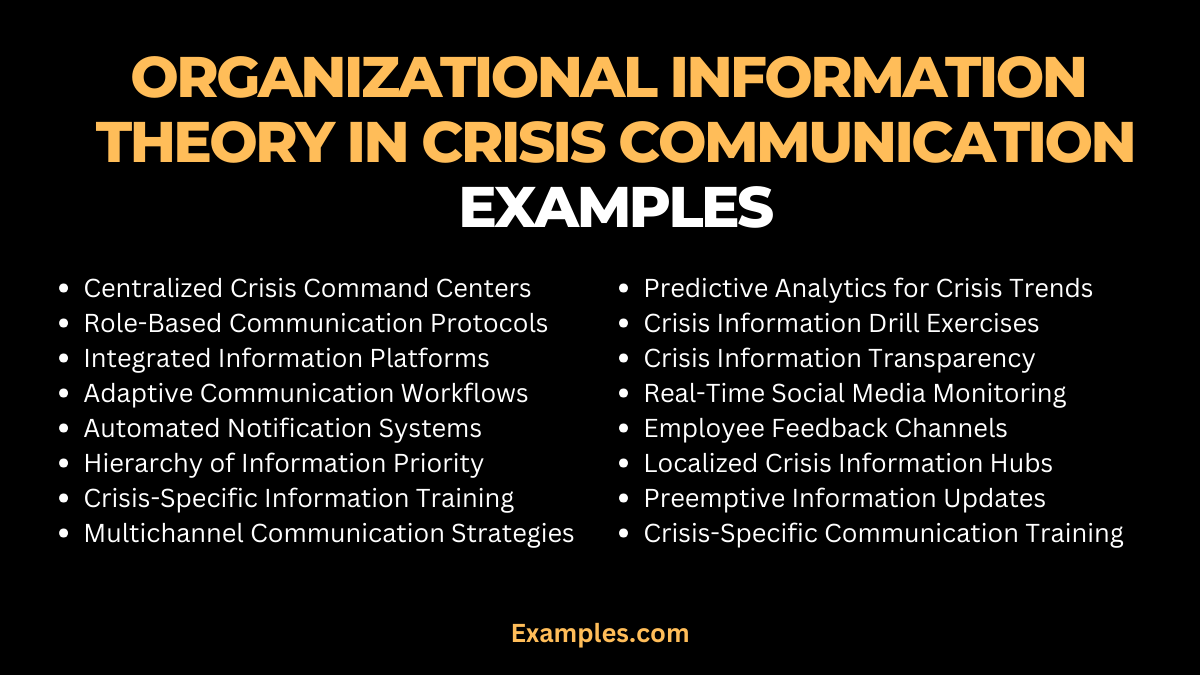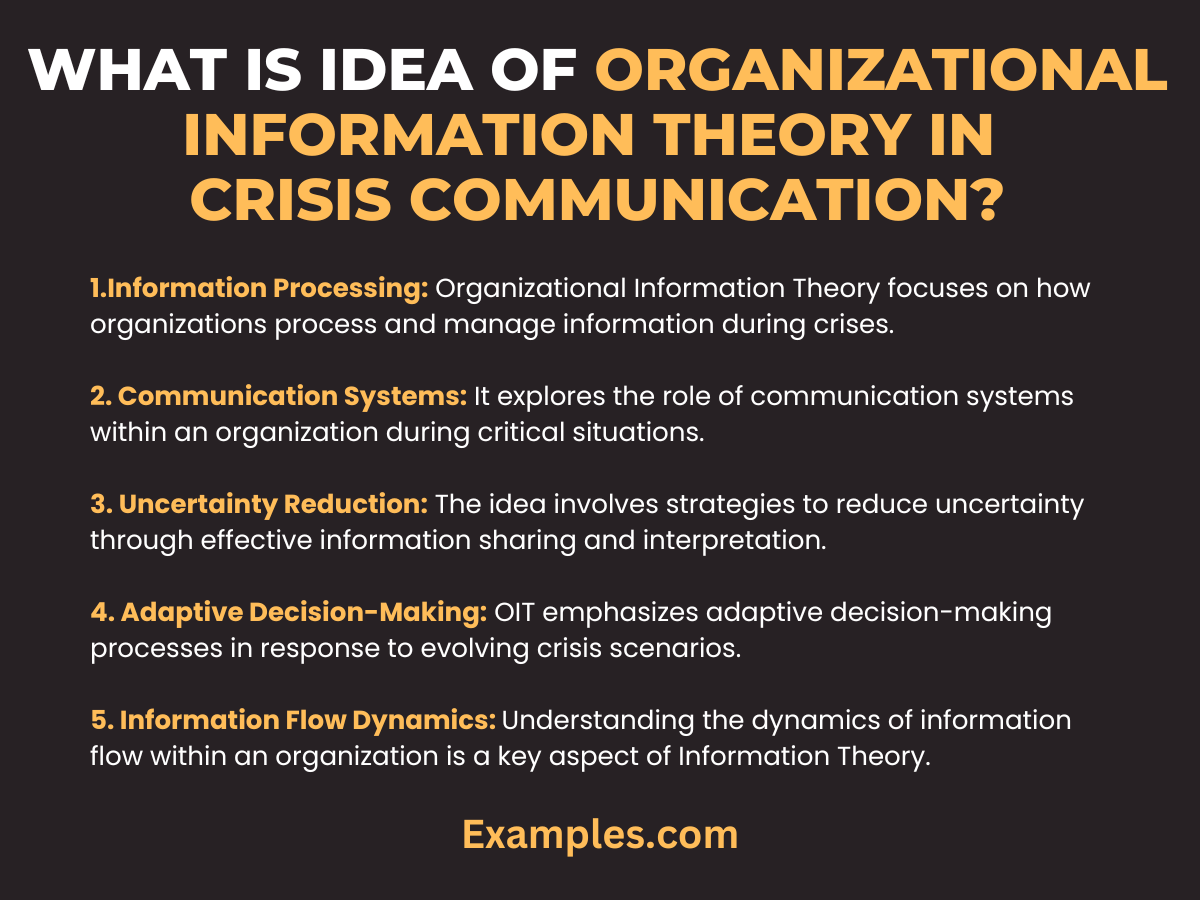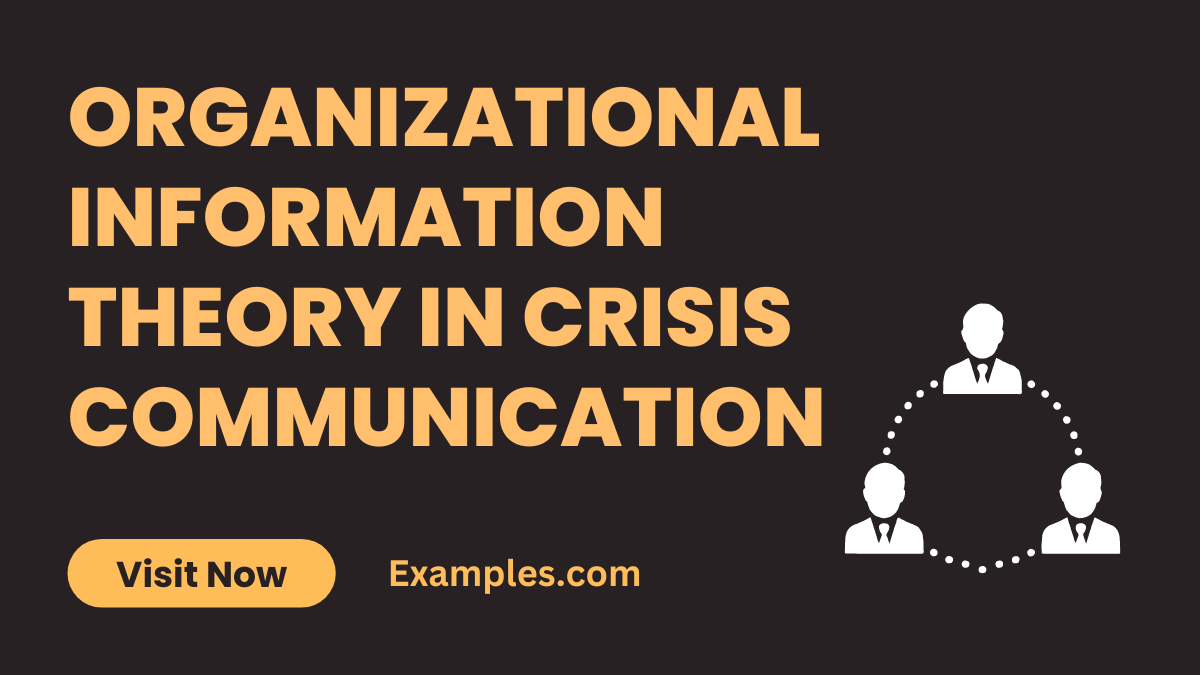19+ Organizational Information Theory in Crisis Communication Examples
Embark on a comprehensive journey into crisis communication with Organizational Information Theory. This guide delves into the theory’s intricacies, providing real-world examples that illuminate how organizations leverage information to navigate crises effectively. Uncover communication examples that showcase the theory’s application, offering valuable insights for crafting resilient crisis communication strategies. Empower your organization with actionable knowledge, ensuring a strategic and informed approach in the face of challenges. Communication examples await your exploration in this comprehensive guide.
What is Organizational Information Theory in Crisis Communication?

Organizational Information Theory in Crisis Communication is a framework that explores how organizations gather, process, and disseminate information during crises. In simpler terms, it examines how information flows within an organization during challenging times, influencing decision-making and communication strategies. This theory aids in understanding how effective communication can be maintained amid uncertainties, contributing to an organization’s resilience in times of crisis.
20 Organizational Information Theory in Crisis Communication Examples

Explore 20 compelling examples illustrating the application of Organizational Information Theory in Crisis Communication. This curated collection showcases how organizations strategically manage and disseminate information during crises, providing valuable insights for communicators navigating turbulent scenarios with resilience and precision.
- Centralized Crisis Command Centers: Establish a central hub for real-time information processing, ensuring swift communication to all stakeholders during crises.
- Role-Based Communication Protocols: Implement role-specific communication protocols to streamline information flow and prevent information overload during crises.
- Integrated Information Platforms: Utilize integrated platforms to aggregate and disseminate relevant crisis information efficiently, maintaining clarity and consistency.
- Adaptive Communication Workflows: Develop adaptive workflows that adjust communication strategies based on evolving crisis scenarios, promoting flexibility and resilience.
- Cross-Functional Crisis Response Teams: Form cross-functional teams with representatives from various departments, fostering collaborative information sharing for effective crisis responses.
- Automated Notification Systems: Deploy automated notification systems for instant dissemination of critical information, ensuring stakeholders receive timely updates.
- Hierarchy of Information Priority: Establish a hierarchy for information priority, ensuring essential details are communicated first for quick decision-making during crises.
- Crisis-Specific Information Training: Conduct training on handling crisis-specific information, equipping employees to communicate effectively in high-stress situations.
- Dynamic Crisis Communication Playbooks: Develop dynamic playbooks that adapt to different crisis scenarios, guiding communicators on information dissemination tailored to each situation.
- Multichannel Communication Strategies: Implement multichannel communication strategies, ensuring information reaches diverse stakeholders through preferred channels during crises.
- Predictive Analytics for Crisis Trends: Utilize predictive analytics to identify potential crisis trends, allowing organizations to proactively manage and communicate emerging challenges.
- Crisis Information Drill Exercises: Conduct regular crisis information drill exercises, refining communication protocols and ensuring readiness for effective information flow.
- Crisis Information Transparency: Embrace transparency in crisis information sharing, building trust among stakeholders through honest and open communication.
- Real-Time Social Media Monitoring: Monitor social media in real-time for crisis-related discussions, enabling organizations to respond promptly and control the narrative.
- Scenario-Specific Information Templates: Develop templates for different crisis scenarios, facilitating consistent communication by providing a structured approach.
- Strategic Crisis Communication Dashboards: Create dashboards for visualizing and analyzing crisis information, aiding leaders in making informed decisions swiftly.
- Employee Feedback Channels: Establish feedback channels for employees to contribute insights and concerns, enriching the organization’s information pool during crises.
- Localized Crisis Information Hubs: Develop localized information hubs to address region-specific concerns, ensuring targeted communication and relevance during crises.
- Preemptive Information Updates: Anticipate stakeholder information needs and provide preemptive updates, demonstrating proactive crisis communication.
- Crisis-Specific Communication Training: Conduct training sessions focused on effective communication during specific crisis types, empowering teams to disseminate information with precision.
Organizational Information Theory in Crisis Communication Examples at Work
Explore real-world applications of Organizational Information Theory in workplace crisis communication. This guide uncovers how effective information management contributes to crisis resilience within organizational settings. Delve into examples showcasing adaptive strategies that ensure seamless communication during challenging work scenarios.
- Dynamic Team Briefings: Conduct dynamic team briefings, ensuring information flows efficiently among team members and fostering collaborative crisis responses.
- Task-Specific Communication Channels: Establish task-specific communication channels for targeted information dissemination, preventing confusion and promoting clarity during work-related crises.
- Employee Empowerment Platforms: Implement platforms that empower employees to share critical information, fostering a culture of collective responsibility and proactive crisis communication.
- Cross-Departmental Crisis Hubs: Create crisis hubs involving representatives from different departments, facilitating cohesive communication and a unified approach to crisis resolution.
- Proactive Crisis Information Workshops: Conduct workshops on proactive crisis information sharing, equipping employees with the skills to communicate effectively in high-pressure work situations.
Why Organizational Information Theory in Crisis Communication Important?
Organizational Information Theory (OIT) is pivotal in crisis communication for several reasons:
- Strategic Decision-Making:
- OIT aids in strategic decision-making during crises by ensuring the timely and accurate flow of information.
- Enables leaders to make informed choices, steering organizations through challenges.
- Minimizing Uncertainty:
- Reduces uncertainty by providing a structured approach to information sharing.
- Helps organizations navigate crises with a clear understanding of unfolding events.
- Building Stakeholder Trust:
- OIT fosters transparency, building trust among stakeholders through open communication.
- Trust is crucial during crises, enhancing organizational credibility.
- Adaptive Communication Strategies:
- Allows organizations to adapt communication strategies based on the nature and severity of crises.
- Enhances flexibility in response to dynamic situations.
- Efficient Information Flow:
- Ensures efficient information flow within the organization.
- Prevents information bottlenecks and ensures stakeholders receive timely updates.
- Crisis Response Resilience:
- OIT contributes to organizational resilience in crisis response.
- Organizations equipped with effective communication strategies navigate crises more resiliently.
What is the Idea of Organizational Information Theory in Crisis Communication?

The idea behind Organizational Information Theory in Crisis Communication revolves around structured information management:
- Information Processing: Organizational Information Theory focuses on how organizations process and manage information during crises.
- Communication Systems: It explores the role of communication systems within an organization during critical situations.
- Uncertainty Reduction: The idea involves strategies to reduce uncertainty through effective information sharing and interpretation.
- Adaptive Decision-Making: OIT emphasizes adaptive decision-making processes in response to evolving crisis scenarios.
- Information Flow Dynamics: Understanding the dynamics of information flow within an organization is a key aspect of Organizational Information Theory.
How Organizational Information Theory in Crisis Communication Helps the Business?
Organizational Information Theory is a valuable asset for businesses facing crises. It aids in:
- Efficient Decision-Making: OIT streamlines information, enabling quicker and more informed decision-making during crises.
- Preventing Information Overload: By categorizing and prioritizing information, OIT prevents overload, ensuring stakeholders receive pertinent details.
- Adaptive Communication Strategies: OIT promotes the development of adaptive communication strategies, allowing businesses to adjust to evolving crisis scenarios.
- Building Stakeholder Trust: Clear and transparent communication facilitated by OIT builds trust among stakeholders, vital for business continuity.
- Resilient Crisis Response: OIT equips businesses with the tools to maintain resilience, enabling them to navigate crises with agility and effectiveness.
In conclusion, this comprehensive guide illuminates the vital role of Organizational Information Theory in Crisis Communication. By dissecting examples and strategies, it unveils the theory’s transformative impact on information management during crises. As organizations navigate turbulent waters, embracing OIT ensures not only effective crisis response but also cultivates a culture of adaptability, transparency, and resilience in the face of challenges.



